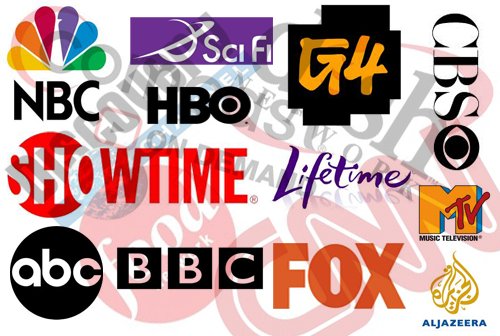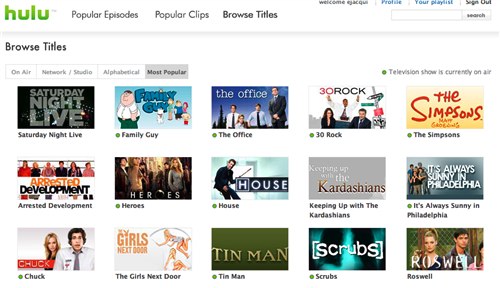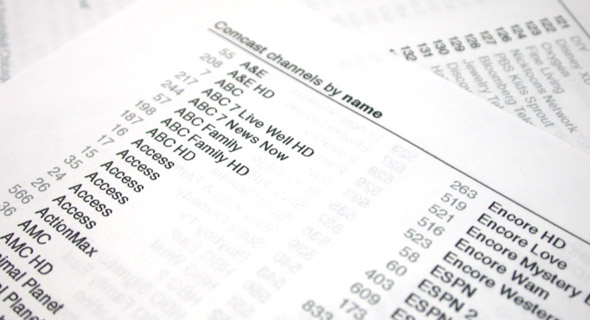“Choice Fatigue,” Community and the Mutations of Television
Graeme Turner / University of Queensland

It was in John Ellis’s work that I first encountered the notion of ‘choice fatigue’: the ‘feeling that choices are simply too difficult; a nostalgia for pattern, habit and an era when choices seemed few1. This, from 2002, when it seemed like the range of choices available to television consumers, particularly in the US, was infinitely expandable. Of course, it is common knowledge now that even when we have a hundred channels to choose from, we still only watch between 8 and 15 favourites, so there is a limit to the number of choices we actually make as we select our television viewing. Ellis suggested that the proliferation of choice had already hit that limit and that its necessity was becoming ‘an imposition’ rather than a freedom.
I had occasion to deal with this in practical terms during a lengthy stay in the US earlier this year, with a premium cable package in my apartment and the research objective of spending some time just watching US TV. My excuse for such an indulgence is the significant differences in the experience of watching TV, notwithstanding theories of globalization, depending on where it takes place. In Australia, where I live, broadcast TV still rules, with subscription penetration at around 30%, a duopoly of metropolitan pay providers, and a no-frills Freeview2 system delivering 15 digital broadcast channels. Most of the online video options that Americans can take for granted, such as Hulu, are unavailable; video rental stores are allocating increasing amounts of shelf space to season collections of the premium programming that features so prominently on the Hulu menus –- Thirty Rock, Mad Men, The Wire, and so on. So far, for the television viewer in Australia, choice is neither an imposition nor complicated. Even though all digital television sets can access an online guide, the full daily program schedule is still listed in metro newspapers, and the weekly program listings are in the weekend supplements.

Watching television in the US, then, was a novel experience – with hundreds of channels available through my television as well as many more options online, in a context where it is simply impossible to have all the options listed in other media or, alternatively, where the uninitiated can spend hours scrolling through the list on the TV’s channel guide. As a television scholar, I knew what I wanted to see but once I had satisfied those preferences and began to explore other possibilities, I was lost in what is, overall, a relatively featureless landscape of choice. Individualizing one’s media consumption sounds like a great idea, but as an outsider in this media culture, I needed help to do it.
When I asked my students how they chose what they watched, they were clearly puzzled at such a naive and basic question. Whatever practices they had developed were of course naturalized, unremarkable. Most did not watch broadcast television, at least not without time-shifting; some did not have a television set but used their laptops; and none would have consulted a print television guide in years. In general, they actively chose specific television programs, but grazed through menus online. In such respects, they epitomised the highly individualized, finely customized, twenty-first century mode of consuming media. But what they actually watched was not quite like that. There was substantial overlap across their personal ‘playlists’ –a loose repertoire of programming that could be taken for granted as something they would all have seen. There was clearly a taste community in operation here. Exactly how it operated, though, they couldn’t tell me.
I am interested in this because I have been examining the recent mutations of television with a view to understanding how, if at all, television might still play what was once seen to be virtually its primary cultural role – constructing a local, national or regional community. The US is important for this project because there, most would argue, that role has receded as television has entered a post-broadcasting era in which the multi-channel system addresses the tastes of the individual. But multi-channel environments in other places I have studied don’t necessarily work this way. To take two very different examples, in the UK, for instance, and in Mexico, in my opinion, the address to a national community is still there – albeit in interestingly different ways—even through subscription services3. Marwan Kraidy’s work on Arab television also demonstrates the complicated ways in which television still plays an active national role even as its political and commercial structures evolve4 into a closer relation to transnational systems.
In television and new media studies, it has become customary to attribute a special political significance to the expansion of choice. Implicit in much of the theorising of convergence culture is the proposition that the expansion of choice directly enables a new level of empowerment for the individual consumer, as if the answer to the power of the media production industries lies simply in their technical diversification. There really needs to be some evidence that shows us how that putative power is actually used. If Ellis is right and the endless proliferation of what are often relatively insignificant choices is as likely to become a burden as a benefit, then it might be useful to know that; certainly, before we assume that this is part of a process of media democratization.

My experience in my apartment in Philadelphia, negotiating hundreds of channels in search of interesting entertainment as well as the locations where I might witness the construction of community, was often one of choice fatigue. Time and again, I found, I retreated to the familiar — programming I could have watched from an apartment in most places in the West, including Australia. What I needed to tailor my choices a little better than that came from talking with my students, and with my colleagues. As a visitor, this is all I had available to me that could function as a community. Individualized these choices might have been, and more pleasingly customized as time went on, but I didn’t make them on my own.
In the broadcast era, we undertook research into fan cultures, and into specific sectors of the audience whose modes of consumption and cultural identities differentiated them from the mainstream television consumer –- who, I remember, we thought we more or less understood. It looks to me now as if we no longer properly understand (if, indeed, we ever really did) the modes of consumption employed by this mainstream television consumer. In particular, even in an environment such as the US which is saturated with choices, we know little about how these individualized viewers make their choices — something that did not concern us before but is very much of interest now as we think about how television might continue to construct communities. As television studies reinvents itself to accommodate the mutations in its objects of study, it needs to more directly examine this aspect of the varied cultures and communities of use that are now building up in response to the multiple systems delivering television around the world.
Image Credits:
1. Composite by Daniel Stuyck
2. Ars Technica
3. C82.net
Please feel free to comment.
- Seeing Things: Television in the Age of Uncertainty, London, I.B.Taurus, 2002, p. 171 [↩]
- This is modelled on the British Freeview system of aggregating free-to-air digital channels as a menu of choices that can represent itself in competition to subscription services. In the UK, there are more than 40 channels freely available at the one-off cost for a set-top box. [↩]
- See Graeme Turner, ‘Television and the nation: or, doesn’t this matter anymore’. In Graeme Turner and Jinna Tay (eds.) (2009) Television Studies after TV: Understanding television in the post-broadcast era , Routledge, London and New York. [↩]
- Reality Television and Arab Politics: Contention in public life, Cambridge University Press, New York, 2010. [↩]
Pingback: The Chutry Experiment » Choice Fatigue: Television vs. Film
In link to the idea of time-shifting, it is fascinating (and oh so convenient if you have access to the web) that it is possible via the Internet to search for and watch virtually every episode of many shows that either haven’t come out on DVD yet, or you simply missed as it was broadcast. It means that not only can you watch a program that you missed from the current television line-up, but find shows that have long been off-the air. It opens up the possibilities of time-shifting even more, and offers a greater cornucopia of choice than ever. But it seems that even with the Internet, viewing preferences still fall relatively narrowly. Indeed, the web opens up greater possibilities too for serialized video content that will never make it onto broadcast or cable television (opening up whole new levels of the aptly named “choice fatigue”). Does the web allow for even greater individualization in choice in viewing patterns? Does choosing not only when you watch something (VCR, Tivo, or when it’s on tv), but the platform change the level of individualization? How does this change the construction of community (local, national, or regional) and address? If we can see that “television still plays an active national role even as its political and commercial structures evolve into a closer relation to transnational systems”, how does the transference of television content onto the web (or even original serialized videos-webisodes) change this? Does it? The internet has so drastically altered possibilities for building communities, I think the questions raised in this article are very interesting applied to the web also.
The vast explosion of choice on the internet lead to a new level of empowerment for the consumer (dependent perhaps on your knowledge of the web, and where to go for content). If the Internet represents a greater opportunity to choose in the way it’s set up, what do the current debates and convergence (i.e. Comcast and NBC)surrounding the internet and ownership portend for a greater level of individualized consumption (doom)?
As a huge consumer of television this article intrigued me straight from the title. There is simply too much programming to choose from but yet it is hard for me to complain. As a filmmaker who wants to create television shows it increases my chances of getting one of my ideas picked up. Yet while reading this article I had my consumer hat on rather than my filmmaker hat. Graeme makes a great point when he says, “Of course, it is common knowledge now that even when we have a hundred channels to choose from, we still only watch between 8 and 15 favorites, so there is a limit to the number of choices we actually make as we select our television viewing.” It is true because most of us are so busy we only have time to keep up with that many shows. I catch most of mine online even though I have basic cable. If I can’t find them online well that show has unfortunately lost me as a viewer. This made me think that before shows didn’t want to be found online because they weren’t making money, but now I feel that they should want to be found online. It is where most consumers go to get their programming and if they cannot find it they move on to another show. In the near future Hulu and other online sites will make consumers pay to view programming. But if it is cheaper than cable and Tivo, online viewers won’t go anywhere.
What also struck me about this article was the statement about Australian TV and that full daily program scheduling can be found in newspapers and weekly program listings. This took me back to a few years ago when I interned at the TV Guide Channel. On my first day I was shocked to find out that there was no running scroll. Even the magazine wasn’t the same anymore. TV Guide was now doing regular programming and reality television shows. There really was no need for the scroll anymore. Now with any satellite or cable service there is a guide that you can scroll through manually and don’t have to wait for your favorite channel to come around.
With the amount of programming that we can choose from everyone should be happy. It feels like there should be something for everyone and I am sure there is, but I agree with Graeme we need help choosing. We are fatigued by all of the options and there shouldn’t be stress associated with choosing a channel or show. Watching television should be relaxing not a chore.
It’s worth noting the shift in the consumption patterns of viewers. Perhaps some people “still only watch between 8 and 15 favourites”, but increasing numbers of viewers now choose to effectively “binge” on programs, consuming a full season or even a full series at a time. The proliferation of DVDs and streaming access to full seasons allows for this. If as a viewer you enjoy a show, it only seems logical that you would choose to consume it in a fairly condensed amount of time. In a sense the proliferation of TV Shows allows for consumption patters similar to that of the novel, with the queue being the modern bookshelf.
Anecdotally, I fall into the mode of binge consumption, not watching 8-15 shows, but rather, isolating shows and viewing them in bulk. This pattern of viewing is at odds with the traditional funding modes for shows that evaluate their commercial viability by their week-to-week ratings. TV Shows are far less ephemeral and therefore the need to see a show “now” is significantly diminished. With DVRs, DVDs, and streaming sites it is far easier to keep a show in the freezer and consume it at a later date.
I cannot speak to any notion of a Choice Fatigue with regards to Television as I believe that we are in a renaissance for narrative fiction, and I don’t feel the least bit paralyzed by choice (…after all, I can always watch it later); yet I did want to point readers towards a well articulated Ted talk on the “Paradox of Choice.” It’s a great talk, and as the summary states “In Schwartz’s estimation, choice has made us not freer but more paralyzed, not happier but more dissatisfied.” Here’s the link:
Perhaps it’s still too early to see the result of this consumption pattern on which products get financed, but the trend for audiences to view shows in their entirety has arguably added to more complex and self referential shows. Series like “The Wire” are virtually impermeable if they are not viewed in their entirety and in sequence, and the humour of “Arrested Development” is so referential in nature that it almost requires sequential viewing. The shooting pattern of shows has also shifted to mimic film to a greater extent. There was no pilot of ‘East Bound and Down”, instead the entire first season (albeit only 6 episodes) was shot at once, and later edited into 6 distinct episodes. It’s hard to imagine that each one of these examples would have been financed if they were dependent on timed, weekly, “destination” viewing habits.
I feel it is very important to explore this idea of consumption within this new digital and post-network phase because it will inevitably mark the direction television will be going. In reference to a response above mine that brings up the viewers ability to consume whole seasons and or a whole series at one time through the use of DVD’s and streaming, I completely agree. The way television shows are now being watched and the ways in which viewers gain knowledge about them is coming from an ever expanding cataloguing via the internet. Sites like IMDB and especially NETFLIX, which actually caters suggestions towards your preference, are paving the way in viewer consciousness.
I think choice fatigue definitely plays a role in peoples disinterest with flipping through and surfing channels. “A relatively featureless landscape of choice” is the perfect way to describe this notion of why viewers don’t watch anything outside of their established shows. I don’t think appeal of a show comes anymore from just flipping through channels and stumbling on a television show. Such actions usually place the viewer in the middle of a show where they have no knowledge of what is going on, and thus stifles their interest. The growing way viewer’s interest in a show becomes established is through the shows synopsis or reviews online by fellow viewers (like Netflix). Of course face to face interaction still plays a deciding factor of why people of a certain demographic consistently watch the same shows, but as social interaction becomes more and more digital I think the ways in which people will look for new programming will fallow this route.